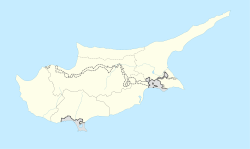Morphou
|
Morphou |
|
|---|---|

The symbolic orange monument at the center of Morphou, representing the town's citrus industry
|
|
| Morphou in Cyprus. | |
| Coordinates: 35°11′53″N 32°59′38″E / 35.19806°N 32.99389°ECoordinates: 35°11′53″N 32°59′38″E / 35.19806°N 32.99389°E | |
| Country |
|
| • District | Nicosia District |
| Country (controlled by) |
|
| • District | Güzelyurt District |
| Government | |
| • Mayor | Mahmut Özçınar |
| Population (2011) | |
| • Total | 18,946 |
| Time zone | FET (UTC+3) |
| Website |
Morphou Municipality Municipality (in exile) |
Morphou (Greek: Μόρφου; Turkish: Omorfo or Güzelyurt) is a town in the northwestern part of Cyprus, under the de facto control of Northern Cyprus. It is the administrative center of the Güzelyurt District of Northern Cyprus. Having been a predominantly Greek Cypriot community before the 1974 Turkish invasion of Cyprus, the town is now inhabited by Turkish Cypriots. With a population of 18,000 people, the town is famous for its apples, vegetables, grapefruit and melons, for which a large proportion of the citrus fruits are exported and the remainder are turned into fruit juice and canned for local consumption and export. Morphou is also famous for its annual Orange Festival, which is a major event lasting two weeks.
Morphou was founded by Spartans who brought with them the worship of Aphrodite. In the Middle Ages, the city was referred to as Morphou but also Theomorphou. The Morphou area grew more than half of Cyprus citrus fruits. In 16th and 17th centuries, during Ottoman period, Morphou was famous for its export of linen.
Between 1907 and 1948, Morphou was one of the prominent stations of the Cyprus Government Railway.
In the wake of the intercommunal violence called "Bloody Christmas", the majority of the Turkish Cypriot population fled the town in January 1964, though one-third remained. As a result of the Turkish invasion of Cyprus in 1974, all of the Greek Cypriots of Morphou fled to the south of the island, and Morphou was inhabited by displaced Turkish Cypriots from the south. These people hailed from various villages in the Paphos district and the town of Paphos, though there were some who came from Limassol and the villages around it. This turned Morphou into a refugee town.
...
Wikipedia

